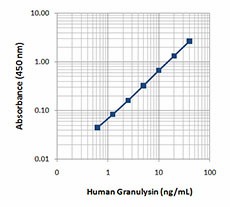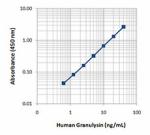- Clone
- DH10 (See other available formats)
- Regulatory Status
- RUO
- Other Names
- GNLY, 519, LAG2, NKG5, LAG-2, D2S69E, TLA519
- Isotype
- Mouse IgG1, κ
- Ave. Rating
- Submit a Review
| Cat # | Size | Price | Save |
|---|---|---|---|
| 526103 | 50 µg | ¥38,720 | |
| 526104 | 500 µg | ¥127,820 |
Granulysin is a cytolytic protein present in granules of human natural killer (NK) cells and activated cytotoxic T lymphocytes (CTLs). Granulysin is synthesized as a 15 kD precursor, which is then cleaved at both the amino- and carboxy-termini into a 9 kD activated form.
The 9 kD granulysin is released into the intercellular space between target and effector cells via a granule exocytosis pathway. The 9 kD granulysin is a chemoattractant for T lymphocytes, monocytes, and other inflammatory cells and activates the expression of a number of cytokines, including RANTES, MCP-1, MCP-3, MIP-1α, IL-1, IL-6, IL-10 and IFN-α.
High serum levels of granulysin are associated with cytotoxic T cell and NK cell activity, and may thus represent a soluble biomarker for host-cellular immune responses. Serum granulysin has also been proposed as a biomarker for the Th1/Th2 balance. At the cellular level, granulysin may serve as a favorable prognostic marker for certain types of cancer.
Product Details
- Verified Reactivity
- Human
- Antibody Type
- Monoclonal
- Host Species
- Mouse
- Immunogen
- Recombinant 9 kD granulysin
- Formulation
- Phosphate-buffered solution, pH 7.2, containing 0.09% sodium azide.
- Preparation
- The antibody was purified by affinity chromatography and conjugated with biotin under optimal conditions.
- Concentration
- 0.5 mg/ml
- Storage & Handling
- The antibody solution should be stored undiluted between 2°C and 8°C. Do not freeze.
- Application
-
ELISA Detection - Quality tested
Neut, IP - Reported in the literature, not verified in house - Recommended Usage
-
Each lot of this antibody is quality control tested by ELISA assay. A concentration of 1 µg/µl of the detection antibody was utilized to gernerate the example standard curve. It is recommended that the end-user titrate each lot of reagents for optimal performance.
- Application Notes
-
ELISA Detection: To measure human granulysin, this antibody can be used as a detection antibody in sandwich ELISA format and paired with the purified DH2 antibody (Cat. No. 348007) as the capture antibody.
Additional reported applications (for the relevant formats) include: neutralization1 and immunoprecipitation1.
Note: For testing human granulysin in serum, plasma or cell culture supernatant, LEGEND MAX™ Human Granulysin ELISA Kit with Pre-coated Plates (Cat. No. 438007 & 438008) are specially developed and recommended. -
Application References
(PubMed link indicates BioLegend citation) -
- Tewari P, et al. 2010. Blood. 116:3465. (Neut, IP)
- RRID
-
AB_2563603 (BioLegend Cat. No. 526103)
AB_2563604 (BioLegend Cat. No. 526104)
Antigen Details
- Structure
- Saposin-like protein family of lipid binding protein, 9 kD and 15 kD
- Distribution
-
NK cells, cytolytic T cells
- Function
- Cytolytic against bacteria, fungi, parasite and tumor cells; chemoattract inflammatory cells
- Cell Type
- Neutrophils, NK cells, T cells
- Biology Area
- Apoptosis/Tumor Suppressors/Cell Death, Cell Biology, Immunology
- Molecular Family
- Cytokines/Chemokines
- Antigen References
-
1. Hanson DA, et al. 1999. Mol. Immunol. 36:413.
2. Spada FM, et al. 2000. J. Exp. Med. 191:937.
3. Kalb ML, et al. 2012. J. Immunol. 188:1583. - Gene ID
- 10578 View all products for this Gene ID
- UniProt
- View information about Granulysin on UniProt.org
Related Pages & Pathways
Pages
Related FAQs
- How many biotin molecules are per antibody structure?
- We don't routinely measure the number of biotins with our antibody products but the number of biotin molecules range from 3-6 molecules per antibody.
Other Formats
View All Granulysin Reagents Request Custom Conjugation| Description | Clone | Applications |
|---|---|---|
| Biotin anti-human Granulysin | DH10 | ELISA Detection,Neut,IP |
Compare Data Across All Formats
This data display is provided for general comparisons between formats.
Your actual data may vary due to variations in samples, target cells, instruments and their settings, staining conditions, and other factors.
If you need assistance with selecting the best format contact our expert technical support team.

















Follow Us